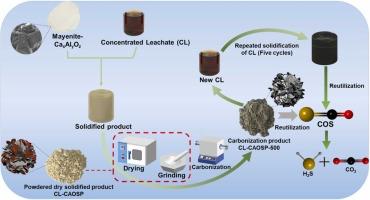Complete solidification of landfill concentrated leachate using a minimal dosage of mayenite and its reutilization for carbonyl sulfide degradation
IF 12.2
1区 环境科学与生态学
Q1 ENGINEERING, ENVIRONMENTAL
引用次数: 0
Abstract
Landfill concentrated leachate (CL) contains high concentrations of organic pollutants, salts, and heavy metal ions. Treatment methods for CL include recharge, evaporation, and incineration; however, these processes are challenged by high load demands, treatment complexity, and limited potential for resource recovery. Herein, the mayenite-enriched calcium-aluminum oxide (CaxAlyOz) was used to solidify CL. With an optimal dosage of 30%, the solidified product, marked as CL-CAOSP, was obtained, which not only mitigates the challenges associated with leachate discharge but also enhances the efficiency of water evaporation due to the lower binding energy at the Ca2Al4O6Cl2•10H2O/Al2O3-water interface compared to that of the water-water interface. To dispose of CL-CAOSP, its organic pollutants underwent a high-temperature pyrolysis carbonization process to form porous carbon, which was tightly combined with the alkali and alkaline earth metals-doped Ca12Al14O32Cl2 to create an efficient hydrolysis catalyst for the toxic gas carbonyl sulfide (COS). The calcined CL-CAOSP is also capable of cyclically solidifying CL up to five times, significantly reducing the required dosage of CaxAlyOz and the generation of the terminal solidified product. These results provide novel treatment and resource utilization technologies for CL, serving as valuable guides for the implementation of CL treatment practices.

求助全文
约1分钟内获得全文
求助全文
来源期刊

Journal of Hazardous Materials
工程技术-工程:环境
CiteScore
25.40
自引率
5.90%
发文量
3059
审稿时长
58 days
期刊介绍:
The Journal of Hazardous Materials serves as a global platform for promoting cutting-edge research in the field of Environmental Science and Engineering. Our publication features a wide range of articles, including full-length research papers, review articles, and perspectives, with the aim of enhancing our understanding of the dangers and risks associated with various materials concerning public health and the environment. It is important to note that the term "environmental contaminants" refers specifically to substances that pose hazardous effects through contamination, while excluding those that do not have such impacts on the environment or human health. Moreover, we emphasize the distinction between wastes and hazardous materials in order to provide further clarity on the scope of the journal. We have a keen interest in exploring specific compounds and microbial agents that have adverse effects on the environment.
 求助内容:
求助内容: 应助结果提醒方式:
应助结果提醒方式:


